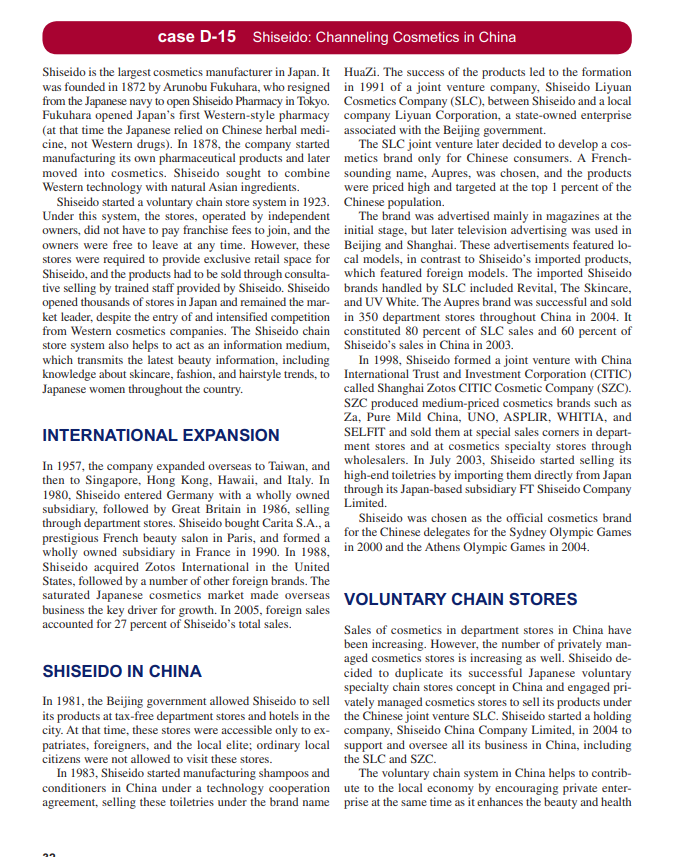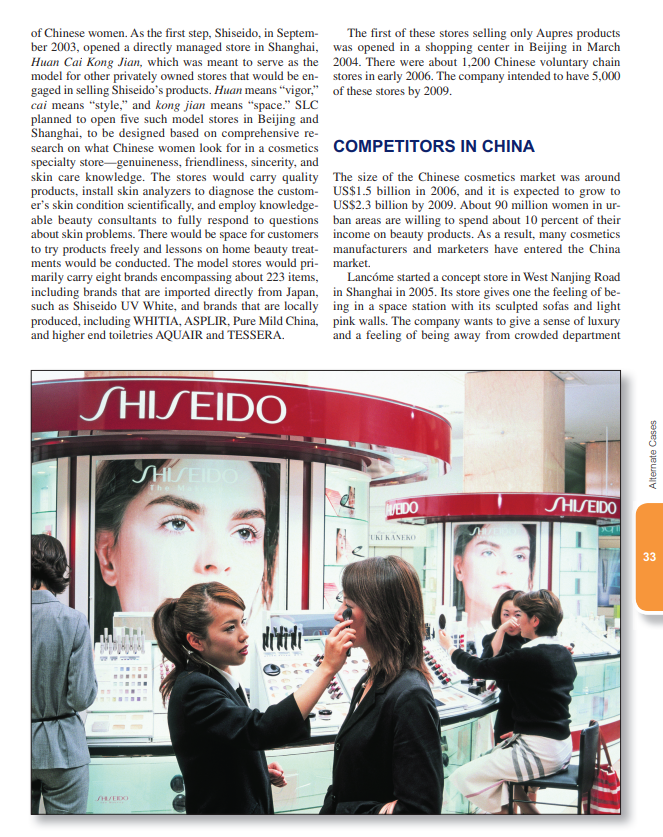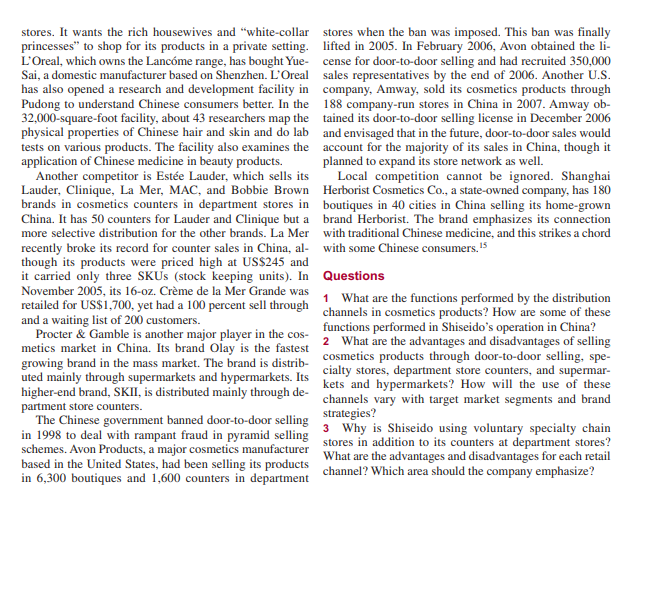Home /
Expert Answers /
Economics /
shiseido-is-the-largest-cosmetics-manufacturer-in-japan-it-was-founded-in-1872-by-arunobu-fukuhara-pa113
(Solved): Shiseido is the largest cosmetics manufacturer in Japan. It was founded in 1872 by Arunobu Fukuhara ...



Shiseido is the largest cosmetics manufacturer in Japan. It was founded in 1872 by Arunobu Fukuhara, who resigned from the Japanese navy to open Shiseido Pharmacy in Tokyo. Fukuhara opened Japan's first Western-style pharmacy (at that time the Japanese relied on Chinese herbal medicine, not Western drugs). In 1878, the company started manufacturing its own pharmaceutical products and later moved into cosmetics. Shiseido sought to combine Western technology with natural Asian ingredients. Shiseido started a voluntary chain store system in 1923. Under this system, the stores, operated by independent owners, did not have to pay franchise fees to join, and the owners were free to leave at any time. However, these stores were required to provide exclusive retail space for Shiseido, and the products had to be sold through consultative selling by trained staff provided by Shiseido. Shiseido opened thousands of stores in Japan and remained the market leader, despite the entry of and intensified competition from Western cosmetics companies. The Shiseido chain store system also helps to act as an information medium, which transmits the latest beauty information, including knowledge about skincare, fashion, and hairstyle trends, to Japanese women throughout the country. INTERNATIONAL EXPANSION In 1957, the company expanded overseas to Taiwan, and then to Singapore, Hong Kong, Hawaii, and Italy. In 1980 , Shiseido entered Germany with a wholly owned subsidiary, followed by Great Britain in 1986, selling through department stores. Shiseido bought Carita S.A., a prestigious French beauty salon in Paris, and formed a wholly owned subsidiary in France in 1990. In 1988, Shiseido acquired Zotos International in the United States, followed by a number of other foreign brands. The saturated Japanese cosmetics market made overseas business the key driver for growth. In 2005, foreign sales accounted for 27 percent of Shiseido's total sales. SHISEIDO IN CHINA In 1981, the Beijing government allowed Shiseido to sell its products at tax-free department stores and hotels in the city. At that time, these stores were accessible only to expatriates, foreigners, and the local elite; ordinary local citizens were not allowed to visit these stores. In 1983, Shiseido started manufacturing shampoos and conditioners in China under a technology cooperation agreement, selling these toiletries under the brand name HuaZi. The success of the products led to the formation in 1991 of a joint venture company, Shiseido Liyuan Cosmetics Company (SLC), between Shiseido and a local company Liyuan Corporation, a state-owned enterprise associated with the Beijing government. The SLC joint venture later decided to develop a cosmetics brand only for Chinese consumers. A Frenchsounding name, Aupres, was chosen, and the products were priced high and targeted at the top 1 percent of the Chinese population. The brand was advertised mainly in magazines at the initial stage, but later television advertising was used in Beijing and Shanghai. These advertisements featured local models, in contrast to Shiseido's imported products, which featured foreign models. The imported Shiseido brands handled by SLC included Revital, The Skincare, and UV White. The Aupres brand was successful and sold in 350 department stores throughout China in 2004. It constituted 80 percent of SLC sales and 60 percent of Shiseido's sales in China in 2003. In 1998, Shiseido formed a joint venture with China International Trust and Investment Corporation (CITIC) called Shanghai Zotos CITIC Cosmetic Company (SZC). SZC produced medium-priced cosmetics brands such as , Pure Mild China, UNO, ASPLIR, WHITIA, and SELFIT and sold them at special sales comers in department stores and at cosmetics specialty stores through wholesalers. In July 2003, Shiseido started selling its high-end toiletries by importing them directly from Japan through its Japan-based subsidiary FT Shiseido Company Limited. Shiseido was chosen as the official cosmetics brand for the Chinese delegates for the Sydney Olympic Games in 2000 and the Athens Olympic Games in 2004. VOLUNTARY CHAIN STORES Sales of cosmetics in department stores in China have been increasing. However, the number of privately managed cosmetics stores is increasing as well. Shiseido decided to duplicate its successful Japanese voluntary specialty chain stores concept in China and engaged privately managed cosmetics stores to sell its products under the Chinese joint venture SLC. Shiseido started a holding company, Shiseido China Company Limited, in 2004 to support and oversee all its business in China, including the SLC and SZC. The voluntary chain system in China helps to contribute to the local economy by encouraging private enterprise at the same time as it enhances the beauty and health
of Chinese women. As the first step, Shiseido, in September 2003, opened a directly managed store in Shanghai, Huan Cai Kong Jian, which was meant to serve as the model for other privately owned stores that would be engaged in selling Shiseido's products. Huan means "vigor," cai means "style," and kong jian means "space." SLC planned to open five such model stores in Beijing and Shanghai, to be designed based on comprehensive research on what Chinese women look for in a cosmetics specialty store-genuineness, friendliness, sincerity, and skin care knowledge. The stores would carry quality products, install skin analyzers to diagnose the customer's skin condition scientifically, and employ knowledgeable beauty consultants to fully respond to questions about skin problems. There would be space for customers to try products freely and lessons on home beauty treatments would be conducted. The model stores would primarily carry eight brands encompassing about 223 items, including brands that are imported directly from Japan, such as Shiseido UV White, and brands that are locally produced, including WHITIA, ASPLIR, Pure Mild China, and higher end toiletries AQUAIR and TESSERA. The first of these stores selling only Aupres products was opened in a shopping center in Beijing in March 2004. There were about 1,200 Chinese voluntary chain stores in early 2006 . The company intended to have 5,000 of these stores by 2009 . COMPETITORS IN CHINA The size of the Chinese cosmetics market was around US billion in 2006, and it is expected to grow to US billion by 2009 . About 90 million women in urban areas are willing to spend about 10 percent of their income on beauty products. As a result, many cosmetics manufacturers and marketers have entered the China market. Lancóme started a concept store in West Nanjing Road in Shanghai in 2005. Its store gives one the feeling of being in a space station with its sculpted sofas and light pink walls. The company wants to give a sense of luxury and a feeling of being away from crowded department
stores. It wants the rich housewives and "white-collar princesses" to shop for its products in a private setting. L'Oreal, which owns the Lancóme range, has bought YueSai, a domestic manufacturer based on Shenzhen. L'Oreal has also opened a research and development facility in Pudong to understand Chinese consumers better. In the 32,000 -square-foot facility, about 43 researchers map the physical properties of Chinese hair and skin and do lab tests on various products. The facility also examines the application of Chinese medicine in beauty products. Another competitor is Estée Lauder, which sells its Lauder, Clinique, La Mer, MAC, and Bobbie Brown brands in cosmetics counters in department stores in China. It has 50 counters for Lauder and Clinique but a more selective distribution for the other brands. La Mer recently broke its record for counter sales in China, although its products were priced high at US\$245 and it carried only three SKUs (stock keeping units). In November 2005, its 16-oz. Crème de la Mer Grande was retailed for US , yet had a 100 percent sell through and a waiting list of 200 customers. Procter \& Gamble is another major player in the cosmetics market in China. Its brand Olay is the fastest growing brand in the mass market. The brand is distributed mainly through supermarkets and hypermarkets. Its higher-end brand, SKII, is distributed mainly through department store counters. The Chinese government banned door-to-door selling in 1998 to deal with rampant fraud in pyramid selling schemes. Avon Products, a major cosmetics manufacturer based in the United States, had been selling its products in 6,300 boutiques and 1,600 counters in department stores when the ban was imposed. This ban was finally lifted in 2005. In February 2006, Avon obtained the license for door-to-door selling and had recruited 350,000 sales representatives by the end of 2006. Another U.S. company, Amway, sold its cosmetics products through 188 company-run stores in China in 2007. Amway obtained its door-to-door selling license in December 2006 and envisaged that in the future, door-to-door sales would account for the majority of its sales in China, though it planned to expand its store network as well. Local competition cannot be ignored. Shanghai Herborist Cosmetics Co., a state-owned company, has 180 boutiques in 40 cities in China selling its home-grown brand Herborist. The brand emphasizes its connection with traditional Chinese medicine, and this strikes a chord with some Chinese consumers. Questions 1 What are the functions performed by the distribution channels in cosmetics products? How are some of these functions performed in Shiseido's operation in China? 2 What are the advantages and disadvantages of selling cosmetics products through door-to-door selling, specialty stores, department store counters, and supermarkets and hypermarkets? How will the use of these channels vary with target market segments and brand strategies? 3 Why is Shiseido using voluntary specialty chain stores in addition to its counters at department stores? What are the advantages and disadvantages for each retail channel? Which area should the company emphasize?